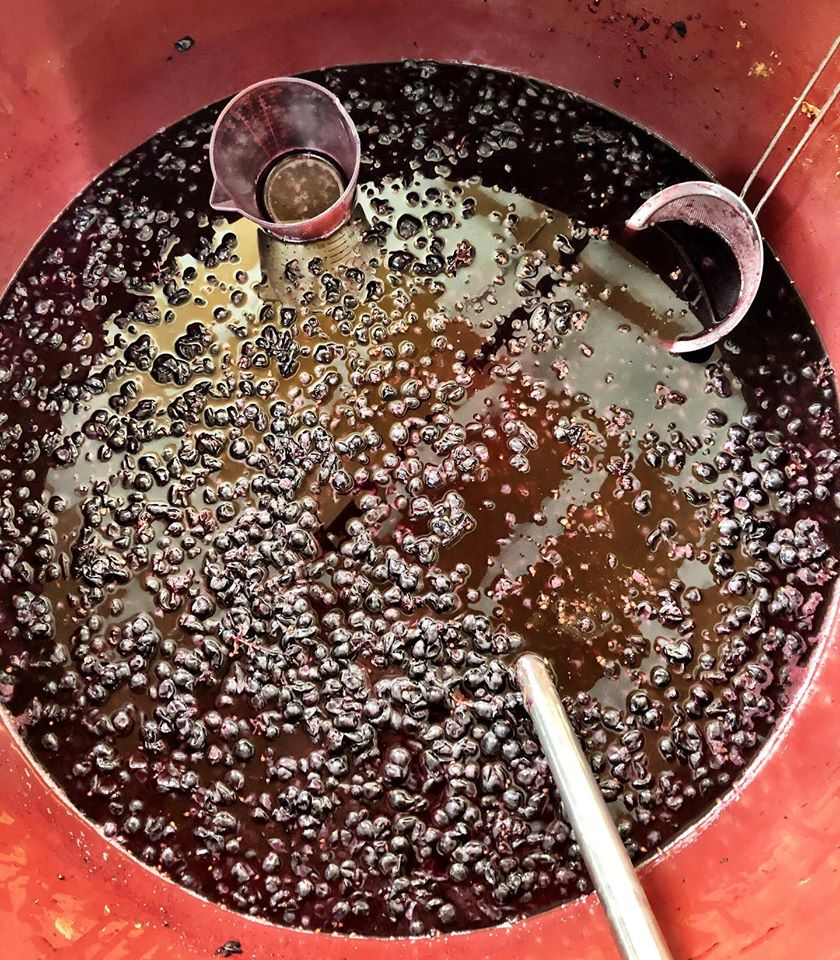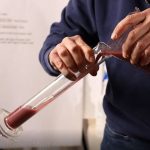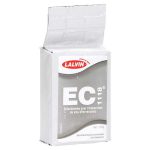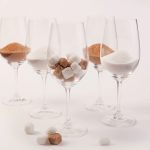How to Avoid a Stuck Fermentation during the Spring Wine Harvest
How to avoid a stuck fermentation

How can you tell if you have a stuck fermentation?
- Your wine is stuck at 2-5 Brix for more than a few days
- Your wine tastes very sweet
What causes a stuck fermentation?
- High sugar levels – 26+ Brix
- High fermentation temperatures
- Low nutrient levels
- Must not punched down or mixed during fermentation
- Inncorrect yeast strain
So.. how can you avoid it?
- If you have high Brix you can water back your must
- You can ice down your must with dry ice or frozen water jugs
- Add the correct amount of nutrients during fermentation
- Punch down and mix must reguarly
- Research and add the appropriate yeast
Not using yeast? Doing a native ferment? Here are some tips to avoid a stuck fermentation
- Keep cellar CLEAN – the cleaner the cellar the less bacteria has the opportunity to flourish and kill your batch
- Check your Brix and make sure they are manageable, if high, water back
- Keep track of your fermentation temperatures
- Keep the temperature in your winemaking cellar as constant as possible
A stuck fermentation can be painful. We highly suggest you take the neccessary steps to avoid it!
Need to fix your stuck fermentation? Check out our video on WinemakingInstructions.com and this Fixing a Stuck Fermentation Blog Post.
For exact measurements and instructions, follow the directions on the manufacturer’s packaging, contact a winemaker at Musto Wine Grape Company for assistance, or download our Full Class offering at WinemakingInstructions.com.
We’re here to help when you need it
As stated above, Musto Wine Grape offers a variety of products as well as services including testing and support. Email winemaker@juicegrape.com or call (877) 812 – 1137 to speak with someone who can assist you.
EC-1118 Wine Yeast: Product Spotlight
What makes EC-1118 so great?
EC-1118. It’s an excellent strain to be used in a wide variety of wines. This includes red and white, including sparkling, fruit wines, late harvest wines and cider. It has a strong competitive character that will inhibit wild yeasts, and restart stuck fermentation due to it’s great alcohol and sulfate tolerance. Being a very neutral yeast, it will have very little effect on the varietal character of the grape. It ferments fully, and flocculates well, producing compact lees. It has extremely low production of foam, volatile acid and hydrogen sulfide (H2S) and it ferments well over a wide range of temperatures (50 to 86 degrees Fahrenheit), making it one of the most favorable and popular wine yeasts.
Considering EC-1118 for your next wine batch? Click here to be directed to our store to purchase online, or call us at (877) 812 – 1137 to place an order with one of our associates. We can also provide a step-by-step instructional for re-hydrating your yeast and adding it to your wine. Whether you’re a newbie home winemaker or a pro, we’re here to help!
My wine is sweet and I don’t want it to be
I made a sweet wine… but that wasn’t my intention!
When a wine that was supposed to be dry ends up sweet by accident, you may find yourself wondering a few things:
A) Why did this happen?
B) Where did I go wrong?
C) What can I do now?
First, let’s get back to basics.
For a wine to have residual sugar (RS) remaining, it must have not completely finished alcoholic fermentation. The only exception to this is if you backsweetened it purposely after it finished fermenting.
Potential root causes
My wine stopped fermenting before I wanted it to
Sometimes a fermentation will not complete despite your best efforts. Check your process – did you do all of the following?
- Start between 22-26 Brix. If it was above or below these numbers, did you make any adjustments?
- Added SO2 pre- chosen yeast add to kill off unwanted wild yeast
- Added a specified yeast strain and followed proper rehydration procedure
- Maintained temperatures so they did not drop too low or get too high
- Added correct amount of yeast nutrient at correct points in time
I accidentally chapitalized more than I meant to
This is a bit trickier to maneuver. Whether you added too much sugar pre-fermentation (to increase eventual alcohol level) or post-fermentation (to backsweeten), you may be stuck with more sugar than your chosen yeast is capable of converting. You could try to restart the fermentation after it initially slows down, but this could potentially increase the ABV way too much depending on how much you added.
You can try to follow a fermentation restart protocol. Or, you can decide to SO2 and add potassium sorbate to the wine and keep it sweet, or you could do bench trials adding acid and possibly tannin to see if you can create a newfound balance within the now sweet wine. *Important note: do not add potassium sorbate to the wine if it has gone through MLF*
I didn’t pitch yeast, I just let it spontaneously ferment
Without choosing a designated yeast that you can be certain will ferment your juice or must to dryness, you risk the possibility of wild yeast starting to ferment but not being able to finish, leading to a stuck fermentation.
I don’t want it to remain sweet. What can I do now?
- If you’re open to doing so, follow a stuck fermentation protocol to restart the ferment. See our blog post for a detailed protocol.
- Blend out the sweet wine with dry wine(s).
- Add acid to strike a balance within the wine – it may still technically be sweet, but by adding acid and/or tannin you may be able to create an enjoyable wine that doesn’t seem as cloyingly sweet as it may without additional acid or tannin.
SOS: Sluggish/stuck fermentation
Many a winemaker has lamented the dreaded stuck fermentation. With so much to deal with during harvest time, the last thing you should be worried about is a ferment that has just up and quit. But sometimes it happens – knowing what to do when it does will be a life saver during an otherwise potentially unfortunate moment in a wine’s life. We’re here to walk you through how to handle this, what to do, and most importantly, how to do it.
Step 1: Think about why it may have gotten stuck
This is going to help you moving forward, both with this wine and with future ferments. Was there too much sugar in the juice or must to begin with? Was the fermentation temperature too cool or too hot? Did you choose a yeast that doesn’t do well with high sugar levels? Were nutrient levels too low?
Considerations before restarting
- Adding lysozyme can halt spoilage organisms which are often present in sluggish or stuck fermentations
- Resuke can lower toxin levels that have accumulated which will give you a better chance for a healthy restart. If you add this you will rack off of it 1-2 days later.
- Incorporate Go-Ferm and Go-Ferm Protect Evolution to ensure health of ensuing restarting fermentation
- Carefully choose what yeast you will re-pitch with. 43, 43 Restart, Fermivin Champion, K1 (V1116), Vin 13, BC, and DV10 are great choices.
Step 2. Add a complex yeast nutrient
This is going directly into the stuck wine tank. If you think you may have a spoilage bacteria problem, this is the time you would be adding lysozyme.
Step 3. Combine equal parts stuck wine and water in another vessel
This is known as the “mother restart tank.” At this moment it will be totaling 2% of whole volume.
Step 4. Rehydrate yeast nutrient + yeast as you would when pitching yeast the first time
This is the exact same process you did during the initial yeast pitch.
Step 5. Add the yeast to the mother restart tank
As always, there should be a <18F difference between the yeast mixture and the mother restart tank liquid temperature.
Step 6. Add 10% of the stuck wine to the starter culture
Wait 20-30 minutes.
Step 7. Add 20% of the stuck wine to the starter culture
Wait 20-30 minutes.
Step 8. Repeat until the remainder of the stuck wine has been added to the mother restart tank
Don’t skimp on waiting the 20-30 minutes at each of the following steps. Give it time to acclimate!
The Winemaker’s Think Tank: Vol 32 – “What do I do if I have a stuck fermentation?”
What’s the Winemaker’s Think Tank?
Every Thursday we will post about a few frequently asked questions that our winemaker has answered. If you have a winemaking question you would like to have answered, please email us at support@juicegrape.com and we will try to get into next week’s post. Cheers! 🙂
What do I do if I have a stuck fermentation?
Sometimes, even though we take great care as winemakers to avoid it, we can get caught with a stuck fermentation. Yeast are incredible creatures, capable of very rapid reproduction, but they do have their limiting factors. It is very important to know the limitations of the certain yeast strain that you are using for your wine. Evaluate your must’s pH to ensure that it is above 3.2, the lower pH environmental threshold for most yeast strains. Take into consideration the alcohol tolerance of the yeast that you selected. If you take the initial Brix level and multiply it by .55, you will have a pretty close estimate of your ending alcohol by volume. Make sure that you haven’t put in a yeast that is unable to handle the rising alcohol levels of the must. Another important factor to consider is the temperature of the must. All yeast strains have a preferred temperature window in which they like to work and reproduce. Because fermentation is an exothermic reaction, check your temperatures (if making reds always take a measurement under the cap) and be sure they haven’t gotten so warm that the yeast may be dying off. The opposite is also true, ensuring that your juice or must have warmed up enough to allow the yeast to begin their processing. Lastly, another important factor to consider in the health of your fermentation is the nutrition of your yeast. Aside from the sugar that they consume, yeast also need proteins, vitamins, and minerals to complete a healthy fermentation. Using a nutrient, such as Fermaid, will give the yeast the other elements needed to properly process the juice.
After the careful evaluation of these factors, you may need to add a small amount of water, nutrients, or heat or cool the must/juice. A winemaker at Musto Wine Grape is happy to help you with the amounts and timing of these additions. If all of these factors have been evaluated and adjusted for, prior to fermentation, and you still have a stuck fermentation, you will need to restart the fermentation. Please contact support@juicegrape.com and a trained winemaker can help you with a restart procedure.
We hope this information helps with your winemaking. If you have any follow up questions or winemaking questions in general, please email us at support@juicegrape.com.











Recent Comments